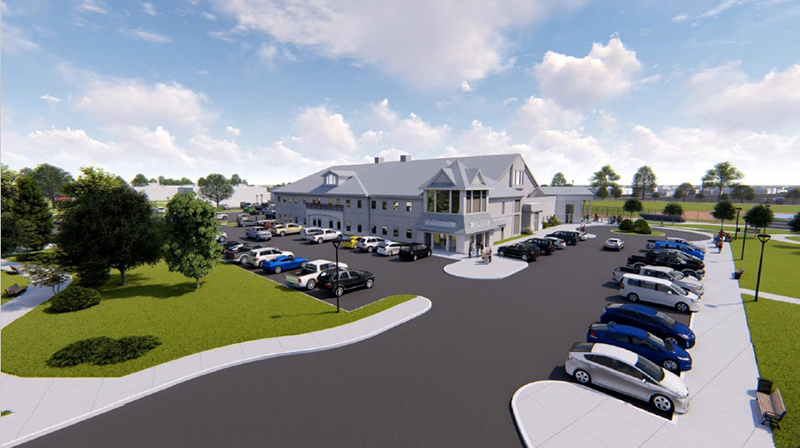Riverhead pitches $100M bond project; will no longer pursue Mercy property

Podcast sponsored by:
Riverhead School District officials announced Tuesday that they will not purchase the former Bishop McGann-Mercy Diocesan High School property to accommodate expanding enrollment.
Instead, officials pitched a roughly $100 million bond proposal that will expand the district’s current assets. That proposition will go before voters in January.
A 2019 facilities analysis presentation by Kevin Walsh and Gary Scheide of BBS Architects outlined the next step the district will take to tackle its steadily increasing enrollment.
The presentation, originally planned for the Aug. 28 board meeting, reported that after research and numerous studies over the summer, the district identified two bond proposal options: a $125 million option that included purchasing and developing the Mercy property, and a less expensive option that would not. District officials and board members selected the less expensive bond referendum.

School board president Greg Meyer said the facilities committee felt the best option was not to pursue Mercy.
“One of the biggest things, for me, was the unknown at the Mercy building,” he said Wednesday. If the board pursued the Mercy option, he added, there could have been additional costs for staff and building abatement.
If approved, the bond would reconfigure several district properties and revamp the fairgrounds next to Pulaski Street School. The architects said the district aims to maintain the historic significance of that site, which used to host the Suffolk County fair in the late 1800s.
The bond would combine the district office and pupil personnel service office in a new separate building near a new, roughly 14,000-square-foot, field house for indoor athletic practice, both on the fairgrounds property. The field house would include a new track and gym and a path would connect both new buildings to the Pulaski Street and Middle schools.
Mr. Meyer said that the new field house is necessary for winter athletes, who do not currently have enough indoor space to practice. The district would also invite community members to use the facility.
“We share our facilities with the town,” he said. “Here, we need each other.”
Riverhead Bond Project by Timesreview on Scribd
The proposal would also convert lighting fixtures in all district buildings to LEDs and enhance security measures. Ceilings, roofing and bathrooms would be upgraded in some district buildings.
Because Pulaski is already over 100 percent capacity and the Middle School is at roughly 70 percent capacity, the bond would reconfigure those buildings and divide students between them.
At the high school, renovations could include additional classrooms and expanded physical education locker rooms.
The bond estimate does not include funding for a new pre-kindergarten wing at Phillips Avenue, which was also discussed at the presentation. Mr. Meyer said that the pre-K option might appear as a separate ballot proposition for voters in January.
To comply with state and legal standards, Mr. Meyer said, the bond proposal must go before taxpayers in January. If it is approved, the board will pursue appropriate documents, applications and state approvals and award contracts to appropriate bidders.
The concept for the bond emerged from the results of an Eastern Suffolk BOCES study showing that projected enrollment in the district would exceed its maximum capacity in 2023, according to previous reports. That prompted officials to consider the possibility of purchasing the Mercy property.
If the bond proposal is accepted by voters, according to the presentation, buildings would be ready for occupancy by September 2023.
The next school board meeting on Thursday, Sept. 19, will focus strictly discussion of the bond referendum, Mr. Meyer said. Additional forums are scheduled for Oct. 15, 22 and 29.
“We understand there’s probably going to be a whole bunch of questions,” he said. “This will require input from the community and … we are eager to hear the community’s input.”
The last bond presented to Riverhead residents was in 2011, when voters approved a $78.3 million proposal. Put forward by the Community Partnership for Revitalization Committee, that plan was a scaled down version of a $124 million proposal voters had rejected in February 2010.
When that bond was shot down, Mr. Meyer said, some necessary renovations, like new bathrooms and lighting, were cut from the budget. Those renovations are now urgent and will be tackled in the new bond, he said.
Tuesday’s presentation showed district enrollment increasing steadily. Demographic data showed that between 2008 and 2018, enrollment rose by 163 students in grades K-4; 161 in grades 5-6; and 172 in grades 7-8.
During the same period, the student body grew by nearly 400 students at the high school, where enrollment is currently at 98.3 percent of capacity. According to the architects, the bond will reduce capacity in all buildings to roughly 85 percent.
Mr. Meyer encouraged Riverhead residents to review the presentation, which was expected to appear on the district website Wednesday and said upcoming meetings will provide more detail.
“The bottom line is that our kids and our community deserve top-notch facilities,” he said, “and that’s part of the role and responsibility we have as a board, along with offering the best education we can for our kids.”








